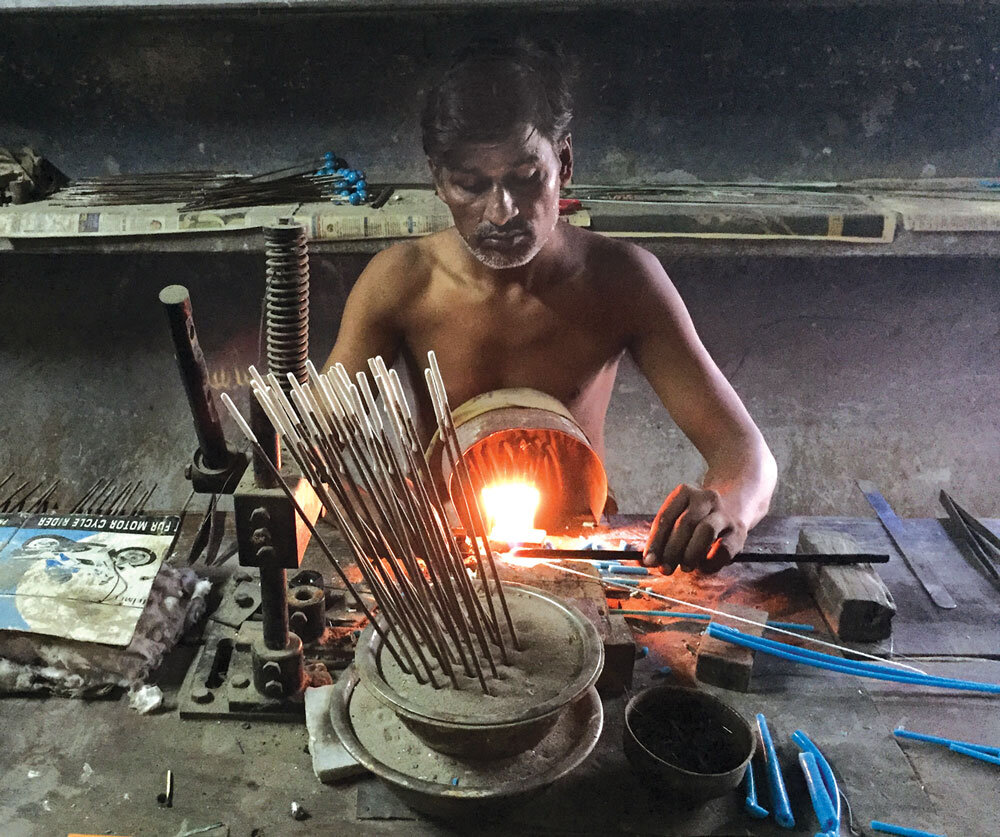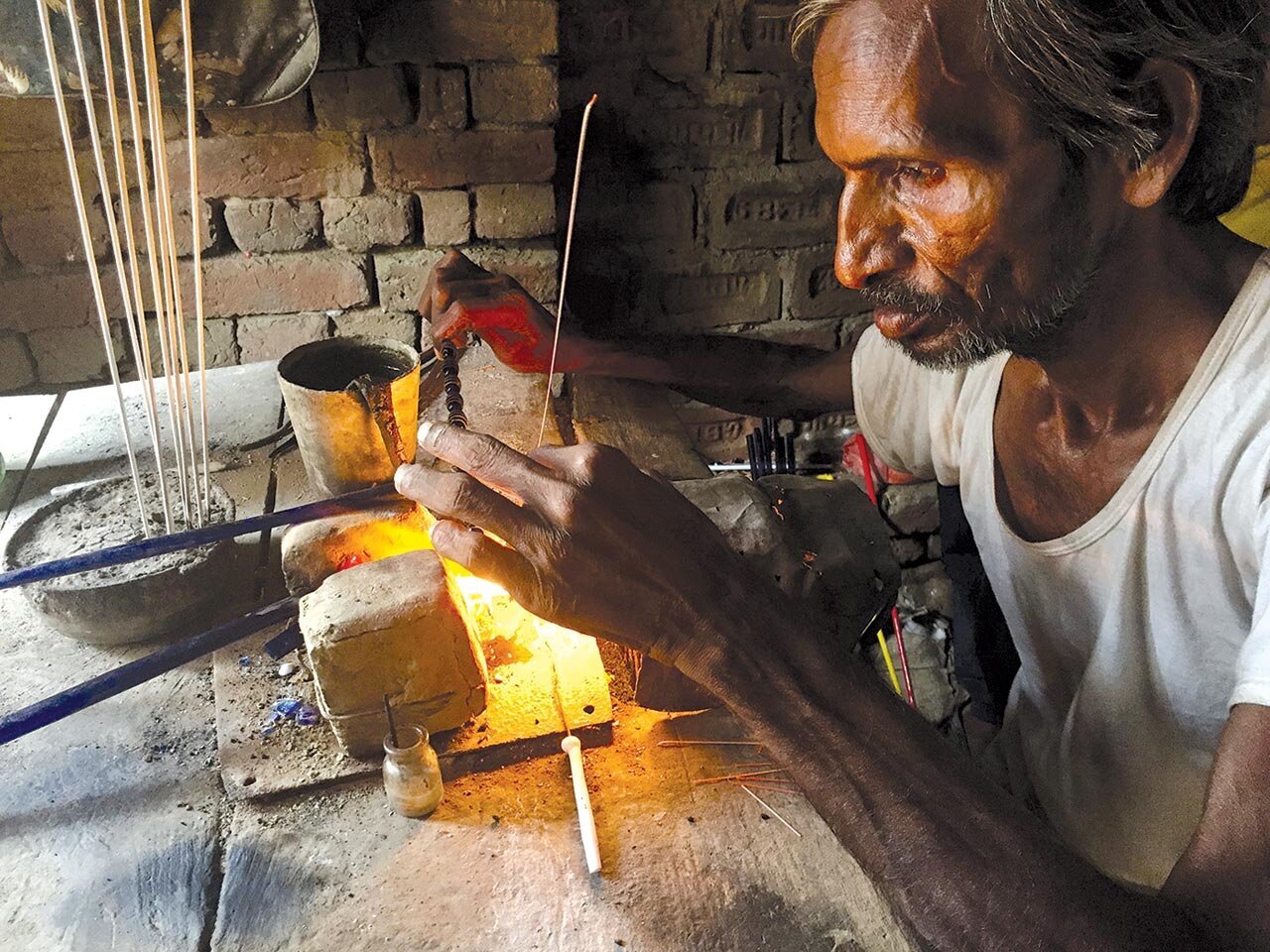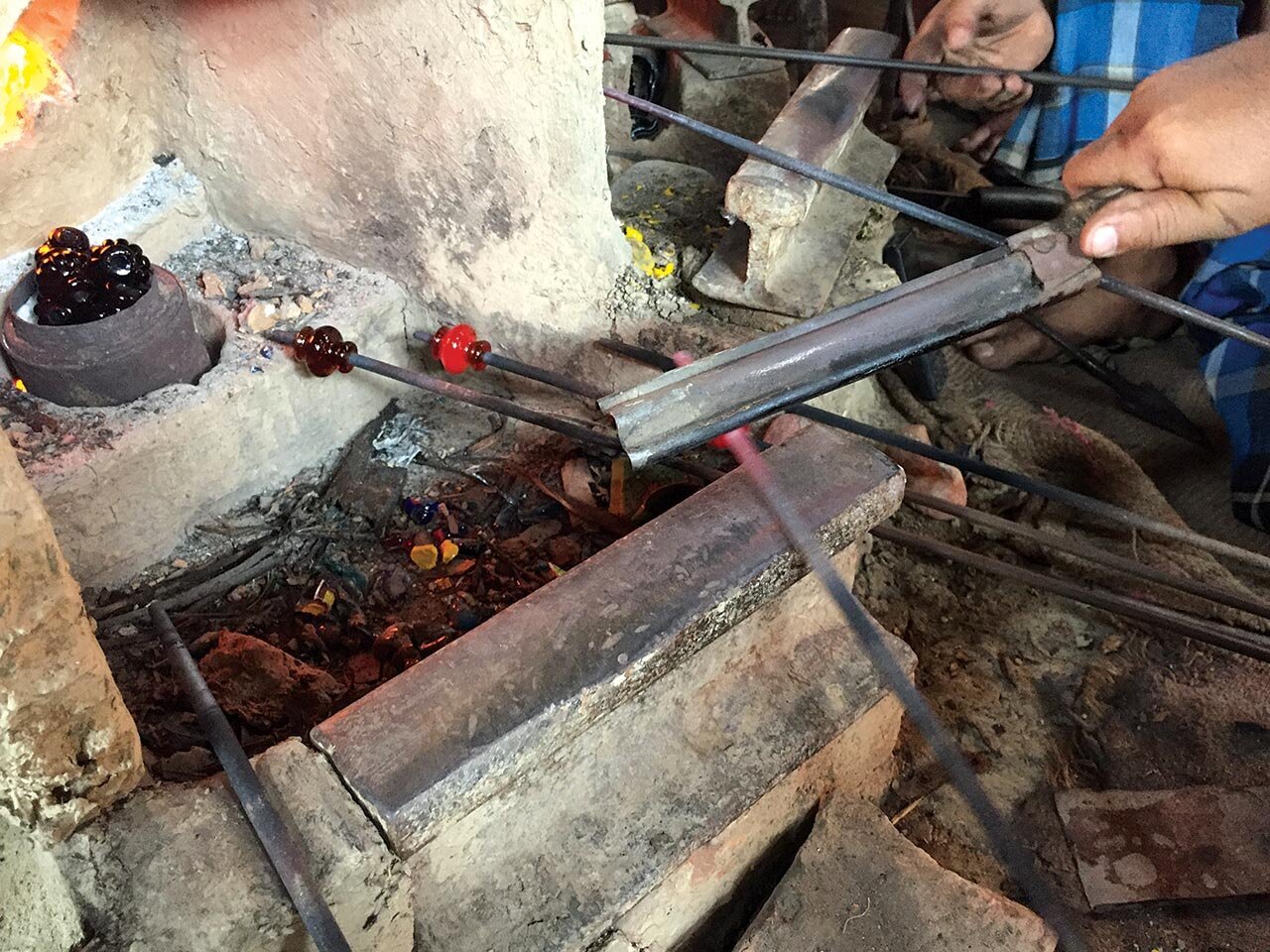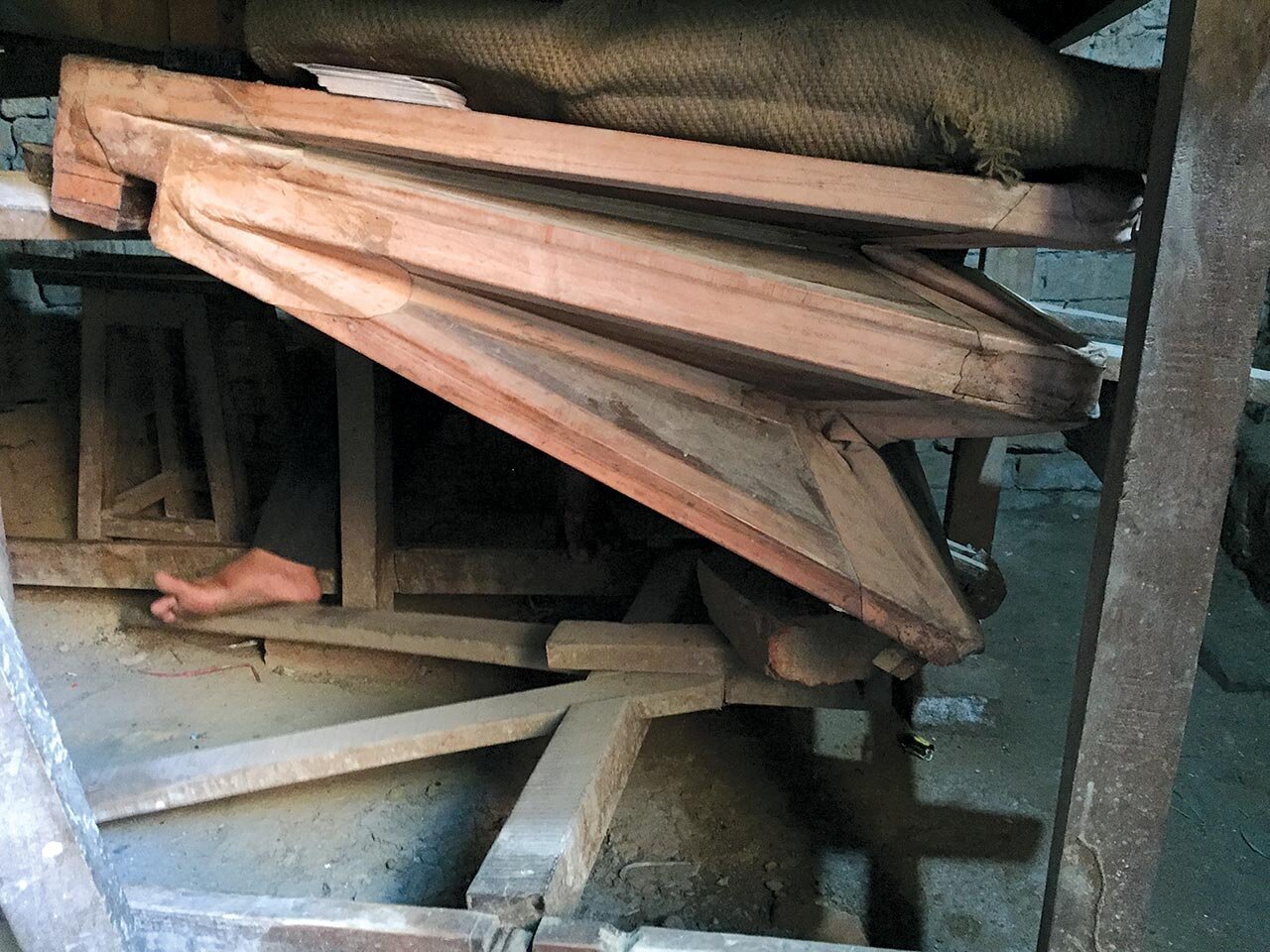Made in India
Throughout history, beads have traveled the world. But not only the beads themselves, the methods for making those beads have also moved from one place to the next.
FINISHING OFF THE FINAL SHAPE of the star cane. You can see the different layers in the glass. The colors do not reflect the final hues. Photographs by Floor Kaspers except where noted.
POURING THE KEROSENE FUEL into the burner. Note, this is a demonstration, as normally this is done when the burner is not lit.
Stepping into the workplace of a glass beadmaker in the Indian village of Purdilnagar is like stepping across time and across continents. The burner, the glass, the technique: it all looks like lampworking in the Jablonec region of the Czech Republic in the first half of the twentieth century. The surroundings, walls made from mud, 100 degree heat, a goat blaring in the distance: twenty-first century India, not too far from the famous city of Agra.
Throughout history, beads have traveled the world. But not only the beads themselves, the methods for making those beads have also moved from one place to the next. Sometimes because resources were low in one place and the makers moved to another area. Sometimes because someone who knew all the ‘trade secrets’ was invited to leave their home and paid well to set up elsewhere. The story of glass beads in India is a fascinating combination between an ancient tradition of making glass beads, new techniques from overseas and continuous innovation and experimentation.
Though India has a long history of glass beadmaking, going back to at least 200 B.C. for beads of good quality, with some beads and bangles dated as early as 1000 B.C., many of the beads that come from India today are made with techniques that have been introduced from elsewhere. The most striking examples of beads with a ‘foreign’ history in India are lampworked beads and chevron beads. Most of these beads are produced in small villages around Varanasi and around Firozabad. Varanasi is the home of Banaras Beads (Banaras is another name for Varanasi), a large producer and exporter of glass beads. Firozabad is the furnace glass capital of India.
Wound lampwork beads are made by melting prefabricated pieces of glass, generally rods, in a directed and intense flame, and winding the glass onto a mandrel. The actual technique of lampworking is fairly modern when compared to the history of glass beadmaking, and started about four hundred years ago in Europe. And it took until 1938 for lampworking to come to India.
WORKER at lampworking station.
Mr. and Mrs. Heinrich (spelling of their name varies between different sources) from the Czech Republic were invited in 1938 by the state of Varanasi in India to come and teach local people to make lampwork beads. This lead to the development of a glass beadmaking program at the Benaras Hindu University that lasted from 1938 to 1962. It was one of those early students who would later on grow to develop one of the largest (if not the largest) production companies of glass beads in the world: Banaras Beads. His name was Kanhalya Lal Gupta, who is the father of the current chairman of Banaras Beads Ashok Kumar Gupta, and grandfather to the current CEO, Siddharta Gupta. He was taught to make lampwork beads at the age of seventeen, and started his company quickly after that. At first, most beads were made for the local market. The beads were often sold at temples. Later on, the company expanded their range and their market. Today, they sell beads around the world. Their types of beads include lampwork beads, handpainted beads, seed beads, molded beads, wooden beads, bone beads, faceted beads, etc. The company has been a major driving force in the development of new techniques, and the adaptation of (mostly) European techniques to methods suitable for Indian beadmakers. Apart from the lampwork beads and the chevron beads discussed in this article, methods for making molded glass beads from thick glass rods, the production of seed beads and several other ways to make glass beads have found their way to India through explorations of both generations of the Gupta family. At the height of the company’s success, the bead business provided work for six thousand people in and around Varanasi and five hundred people in Purdilnagar.
The lampwork beads for Banaras Beads are mainly produced in small villages around the city. The set up in the villages is still very similar to the original set up in the Czech Republic, which has become almost obsolete in Europe today. The burner is a metal box, sitting on a wooden table, into which kerosene is poured through a cavity. The burner has several wicks that burn the kerosene. To direct the flame and increase the heat, foot bellows are used to pump air through the flame from the wicks. The bellows are a specific type of double bellows, that allow for a continual flow of air being pushed through the ports. The workers cover the burner with a half round metal sheet and a piece of cloth to protect themselves from the radiant heat. They make a small ‘wall’ of clay to reflect the heat back behind the burner, similar to the set up in Venice. Some use a cast iron stand for preheating the rods, that is based on the Czech way of preheating the rods. There, it is called the ‘Stein’ (meaning stone) and it is a place to rest the rods on, to preheat them, and a way to preheat certain components. Most lampworkers in India seem to have combined the Venetian method of a small wall behind the working area to reflect the heat with the function of the preheating of the rods in a makeshift combination of carved bricks and clay. Some of the mandrels used around Varanasi are oddly enough made from copper, instead of the more commonly used steel. Copper conducts the heat, so the mandrel gets very hot, especially as they are making many beads on a single mandrel. They use leather finger coverings to keep their fingers from burning. To get even shapes, locally produced brass molds are used for rolling and shaping the beads. These are oiled to stay smooth, and sometimes cooled at the bottom with some dripping water. The oil they use can be anything from ghee (clarified butter) to mustard oil or buffalo fat. In other villages, two-part molds in pliers are used that sit on the wooden table. The top part of the mold is connected with a metal wire through a hole in the table, and it can be pushed down with a press of the feet. Both types of molds are made by striking the shape in a steel punch first. A piece of brass is heated until it is glowing red, and then the punch is pushed into it by the blow of a hammer. This leaves a detailed impression of the desired shape in the brass mold. Often, the beadmakers make many lampwork beads on the same mandrel. The mandrel is first coated in a layer of kaolin clay, that keeps the glass from sticking to the metal mandrel. When the mandrel is full, they place it in between two layers of insulation blanket. This way, they reduce the chance of the beads cracking when they cool down.
A lot of the lampwork beads mimic traditional European made trade beads, but also natural materials like coral and stone. For example, there are lots of beads made with aventurine glass, a glass originally from Italy, that has copper particles suspended in it to give it a golden effect. It is often used in Venetian ‘fancy’ beads, and copied in India. Other examples are beads that are made to look like turquoise or agate. Some of the beads from India can be hard to distinguish from their European counterparts.
At the main factory in Varanasi other types of beads are also made, like molded beads and faceted beads. There are also a few lampworkers working here. They have changed the system of foot bellows to using an air pump with a tube to the torch. This has an additional benefit; they can use a second tube to blow air at their face to cool them down. Here, steel mandrels are used, so the mandrel does not get as hot as their colleagues’ copper ones.
While at first, lampworking was only introduced to the region of Varanasi through the program at the university, it eventually also made its way to another area, Purdilnagar. This town, also called Purdilpur, is not far from Firozabad, which has a huge glass industry. Large furnace glass, sheet glass, cups, bangles, and more, are all done in Firozabad. Purdilnagar has a long history in the production of furnace wound beads and bangles. This production takes place at wood-fired furnaces, that have room for up to twenty ports for individual glass workers. The glass, often recycled glass or scrap glass from Firozabad, is used here to make a variety of beads that include millefiori beads, beads mimicking coral, and large beads with swirls of color.
When the grandfather of Munish Bhardwaj, owner of Marshi International from Purdilnagar, learnt how to make lampwork beads in 1965, he knew this would be a great addition to the production of furnace beads. Lampworking can be done in much smaller workplaces, requires less tools and investment and can create a great variety of beads. The making of lampwork beads quickly became popular in Purdilnagar. Kock and Sode (1994) write: “As, gradually, more beadmakers and workshops came on the scene, many began to teach new people, and this was how the beadmakers from Purdalpur learned to make the lamp worked beads. The more agreeable working conditions and the possibility of setting up one’s own workshop at home have led to an increasing numbers beginning to make blowlamp beads.”
The techniques are very similar to the methods used in Varanasi, and the same goes for the type of beads that are produced. In the last ten years, a lot of workers in Purdilnagar have switched from the use of kerosene to the use of LPG gas. It is a cleaner method, the flame gets hotter, less air pressure is required and it is easily available. They can, however, still use the same burner and table with bellows. Most of the beads are sold either through Banaras Beads, or through smaller local companies that supply the Indian or the international market.
The demand for lampwork beads has decreased significantly in the last ten years. Lampwork beadmaking is a part-time job for most workers. They are now mostly farmers, supplementing their income at the burner when they get an order. This also means that innovation is minimal. There is no time or money to invest in new techniques. In 1994, when Kock and Sode addressed the change to lampworking for the production of glass beads in Purdilnagar, they envisaged a different future for lampwork beads: “This development means that it can be assumed that people will continue to make glass beads in Purdalpur for at least ten or twenty years, but in the future it will be done only as blowlamp work. This method will probably outcompete the traditional methods in a short time.” However, they could not have foreseen the downturn in the global desire for beads, combined with increased competition from China.
The method for making lampwork beads came to India from the Czechs, but the making of chevron beads has a related, but different history. Chevron beads are beads that are made from glass canes that have a star pattern inside. Chevron beads were first made in Venice in the late 1400s and have been a very popular export item to North and South America, Africa and parts of Asia. The traditional method for making chevron beads involves the use of an optic or ‘dip’ mold in the shape of a star. On the end of a metal tube, a gather of hot glass from the furnace is dipped into the mold, to create a star shape. This is then repeated with several layers of glass. When all the layers are complete, the gather of glass, into which a bubble has been blown to create the hole throughout, is pulled into a long cane. When the cane is cut into bead size pieces and ground into a round or oval bead it reveals its chevron pattern.
When Ashok Kumar Gupta, then the CEO of Banaras Beads, visited Venice in 1977, he found a small booklet for tourists that showed the production of chevron beads. With this booklet, he went to the skilled glass workers in Purdilnagar.
With the tradition of furnace work in Purdilnagar, this was the perfect place to experiment with making chevron beads. By combining the local techniques at the furnace with the information on the Venetian method of making chevron beads, they devised a method of making star canes. The chevron beads made in Purdilnagar have become very popular and found their way over to the US in the early 1980s. They can currently be found in markets and shops all around the world.
The workshop we visited was by Hasain Bhai, who has been making these himself since 1990. He also makes flower and star canes used to make millefiori beads, and canes for other drawn beads. While we were there, he made three different canes. Having watched this process before in European and American settings, it was impressive to see what a great result he could get with very limited equipment. His pots of molten glass sit on two sides of a gas powered clay and brick furnace. One of the other sides has an opening that serves as a ‘glory hole’ for reheating the glass gather when it gets too cool to work.
For the chevron cane, which is made up from different star-shaped layers, he builds each layer one star point at a time. The first layer is hollow, by blowing into it from the metal tube he works on. This blown bubble eventually becomes the hole in the chevron beads. When he has added enough layers, the gather gets shaped evenly, and then heated one final time at the glory hole. Then it is pulled into a long cane, after a final push with a metal rod through the tube to make sure the hole goes all the way through. The cane is cut into two feet lengths and put into a metal case on top of the furnace to slowly cool. When the first cane pull of the day is done, they place the box on the hottest area above the furnace. After the second pull, the first box gets moved up, and the newly pulled cane gets the ‘hot seat’. This way, they have reduced a lot of the cracking of beads due to internal stress from cooling too quickly that they previously experienced. The cane is then ground and polished, revealing all the different layers. The grinding and polishing is done at the main factory for Banaras Beads. This used to be done by hand. However, they are now using a cutting and grinding machine in the Banaras factory. About one foot of cane is placed into the machine which has two diamond grinding stones that together create the desired bead shape. In a matter of seconds, the cane is transformed into oval or round beads, that only require tumble polishing to finish it off.
Other types of canes that are made are used in millefiori beadmaking, such as face canes, small stars or flowers. Star canes for chevrons are generally quite thick, more than 1.5 inches/3.8 centimeters. These canes are pulled inside the hallway of the workplace. The other canes start out with a similar amount of glass, which is then pulled much thinner. For this, they place small wooden rests on the street outside, to have enough room for pulling the entire cane.
Bhai’s furnace is powered by gas, which sits in a tank outside the workspace. It sits in a tub of hot water (which gets heated at the furnace) to increase the pressure of the gas tank. Next to it, is a small solar panel, as there is no electricity that goes to the village. The electricity that is generated by the panel is used to power a standing fan, pointed towards Mr. Bhai.
Currently, there are only two workshops producing star canes in Purdilnagar. His brother-in-law, Heider Bhai, who runs the only other canemaking workshop, still uses wood to fire his furnace.
PACKING CONVEYOR BELT at the Banaras Beads factory.
In general, what struck me about beadmaking in India has been the inventive nature of the beadmakers. Their tools are simple, as is their burner or the furnace. Their raw glass is not of a high quality. Yet they manage to manipulate the glass, through trial and error in such a way that they currently produce high quality results. Beads from India can be found at local markets and shops around the world. They are used to ornament anything from bridal gowns to tablecloths. They are sold in prayer strands at the steps of the Ganges river in Varanasi, to local craft stores in the US. Even though, once you know how to recognize them, they seem to be everywhere. At the moment, with the exception of bangles and seed beads, the demand for Indian beads is down. The market in India and overseas has slowed. For many people, beadmaking is now only a part-time job. For others, their workstations are gathering dust. Businesses are closing or transforming. Mr. Gupta from Banaras Beads said, “Bead business is dead” and then continued to show us the vast quantity of glass beads in storage in the factory. Currently, they have over a million pounds of beads in stock, waiting to be sold. Competition from China is fierce, as they have managed to find even cheaper ways to produce beads. But the main problem is the lack of demand. Most local beadmakers that are still working expect to be the last generation of beadmakers in their village. The approximately one hundred people still making beads around Purdilnagar today are mostly part-time workers. Younger generations have migrated to the bigger cities, and are working to find new employment.
The optimists say that there will always remain a demand for beads. Some beadmakers are still experimenting, exploring new markets. Working with new types of glass, like borosilicate glass, designing new beads, making high quality murrini or simply inventing methods to make beads faster. Only time will tell what the future of beadmaking in India holds.
SUGGESTED READING
Francis, P Jr. Beads of the world, A Collector’s Guide with price reference. Atglen, PA: Schiffer Publishing, Ltd., 1994.
Francis, P Jr. Glass beads of India, The world of beads, monograph series 7. Lake Placid, NY: Lapis Route Books, 1982.
Kanungo, A.K. Chevron and millefiorie in India. Journal Borneo International Beads Conference 2019. Kuching: Crafthun Sdn. Bhd., 2019.
Kanungo, A.K. Indian Glass Beads, Archeology to Ethnography. Delhi: Research India Press, 2014.
Kaspers, F. Beads from Jablonec, a history in beads. The Hague: Marblings Publishing, 2014.
Kock, J and Sode, T. Glass, Glassbeads and glassmakers in Northern India. Vanløse, Denmark: THOT Print, 1994.






